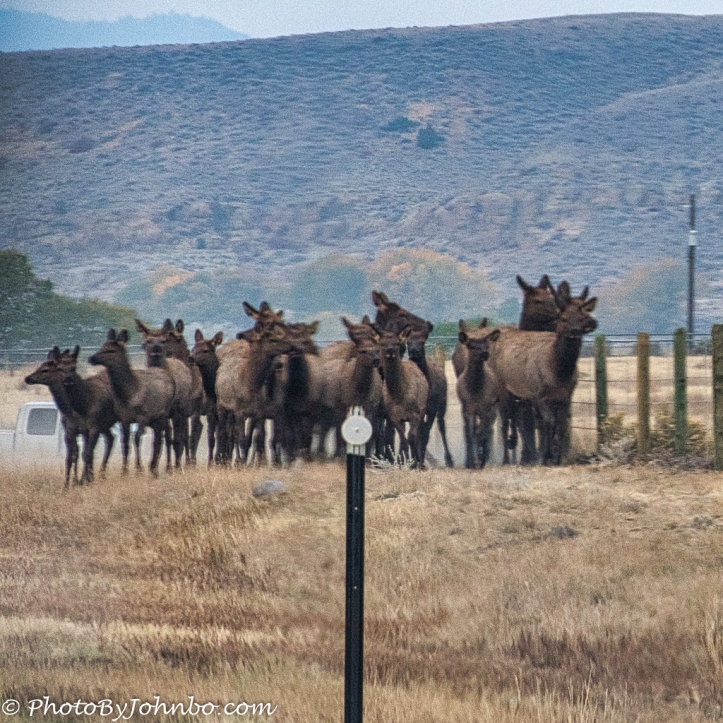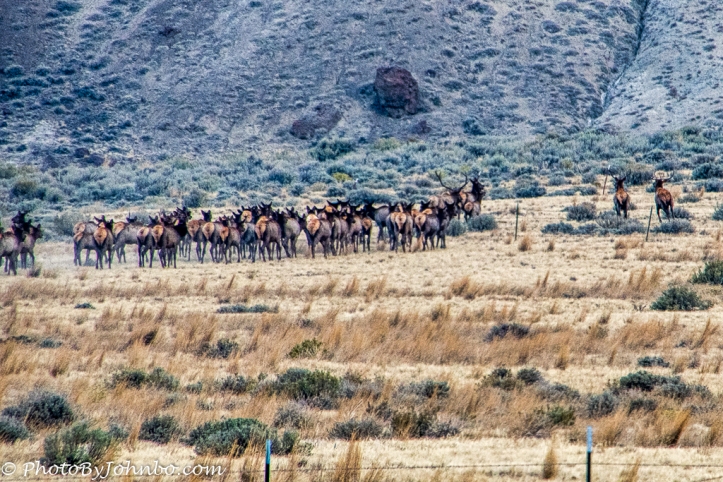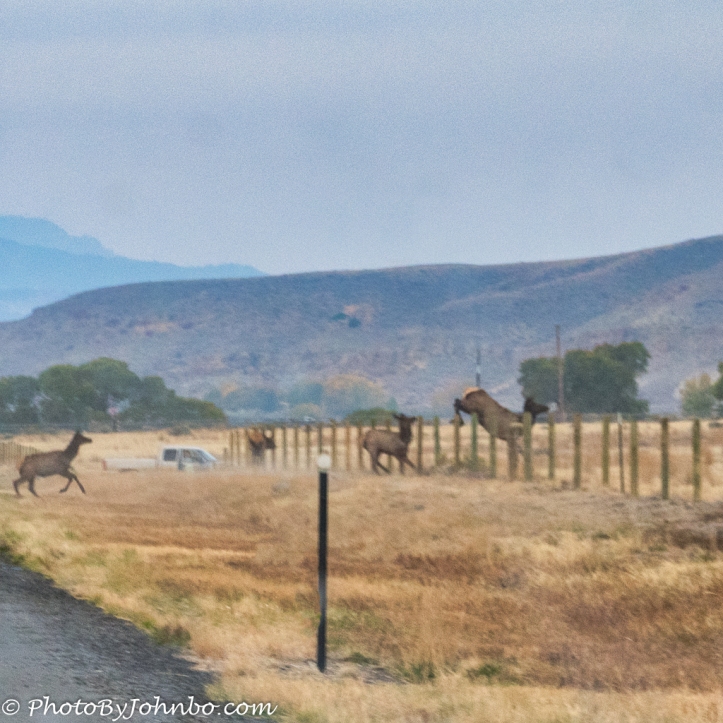Cody, Wyoming.
On our way to visit Yellowstone Park, we were westbound on the highway between Cody and the park. All at once, traffic started to slow, and then the cars in front of us stopped. There were no cars coming in the opposite direction. It was then that I looked out the side window and saw the largest elk herd I’d ever seen. Numbering well over a hundred individuals, the line stretched for some distance. Using my 16-300mm telephoto set to maximum zoom, I captured an image of the lead group well off in the distance.
We were on an east-west highway and a cattle fence paralleled the highway on the north side. There were small groups of elk standing in and around the road with a cluster of them nearest the fence. Many tried to jump the fence but couldn’t make it. It appeared the group at the fence had given up and were collectively looking for alternatives.
At one point, one of the elk in this group had the idea to give it a running start. After backing up to the road and taking a run, it was up and over. Taking the hint, the rest of the group backed away from the fence and followed suit. Eventually, most of the elk cleared the fence and hurried to catch up with the main group which by now was going out of sight.
As the road cleared and traffic started to move, there were still a few individuals stymied by the fence, mostly younger ones that didn’t have the ability to jump the fence.
Only a couple of days earlier, I learned while reading a placard at Craters of the Moon National Monument that elk, pronghorn antelope, mule deer and other migrating animals have real issues with the standard 5- to 6-line barbed wire fencing installed to keep cattle from wandering off the ranch.
Though this style of fencing is over a century old, conservationists have developed techniques for fence design and implementation that either makes the fences easier for wildlife to pass unimpeded, or to lead the animals to safe migrating routes.
In researching this issue, I found two articles that helped me understand the problem and presented a couple of solutions that are being implemented to prevent incidents as we saw on the highway to Yellowstone Park.
The first is posted on the Theodore Roosevelt Conservation Partnership blog titled “How Mending Fences Makes a Difference for Migrating Big Game.”
The author writes, “Barbed wire is perhaps the most pervasive option in big game country, but of course it’s not the only style of fence with impacts for migrating animals. Woven wire fences are almost impossible for wildlife to pass through. When these are combined with a barbed top wire, it is a lethal and impenetrable combination considered the most detrimental to wildlife.”
Examples of solutions being implemented are highlighted there.
The USDA is allocating a budget and providing assistance to ranchers with upgrading their fencing. In an article on the USDA Blog, “New Fences Keep Cattle In, But Allow Elk & Wildlife to Move Freely,” the author describes one such rancher’s project to help pronghorn antelope transit his ranch.
The author writes, “These new fences allow pronghorn antelope and other big game to pass through the fence without the risk of getting tangled in the wires. The fence wire spacing allows pronghorn to crawl under the fence, while the lighter-on-their-feet deer and elk can easily jump over the fence – all with minimum risk of injury.”
Open range ranching all but disappeared after the Civil War and fencing has been a problem for wildlife migration for well over a century. After seeing firsthand how a single fence impeded one great herd of elk, I am happy to see that the problem is finally being addressed.
John Steiner



How fortunate to have witnessed this rare and spectacular moment. This question of barbed wire reminds me of those western films where ranchers and cattle drivers fight with opposing interests.
I thought of that as well. This problem truly has been a century old for wildlife.
In Sweden we are working hard to help wildlife. We have built bridges for them over highways and leading them to safe ways. I am glad it’s improving over there as well.
This event was truly a learning experience for me.
I love learning experiences.
Great post. It’s definitely rare to see this migration. Lucky that you got a chance to see it. Great pictures and loved reading about the fence.
Thank you. It was truly a unique experience!